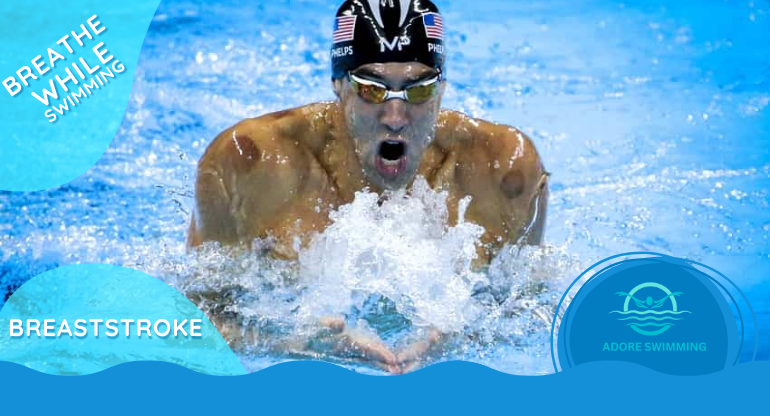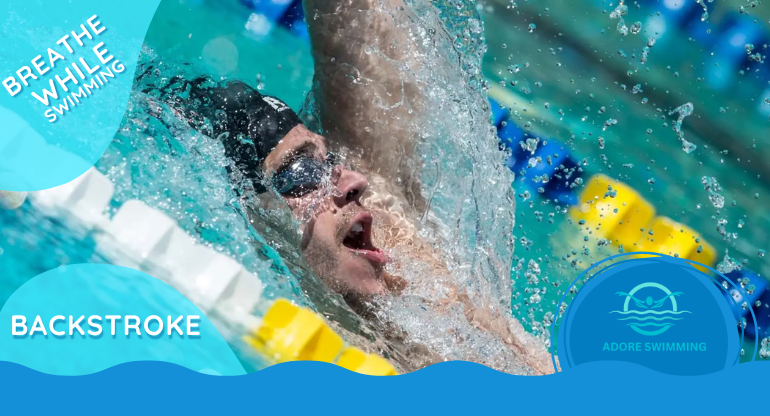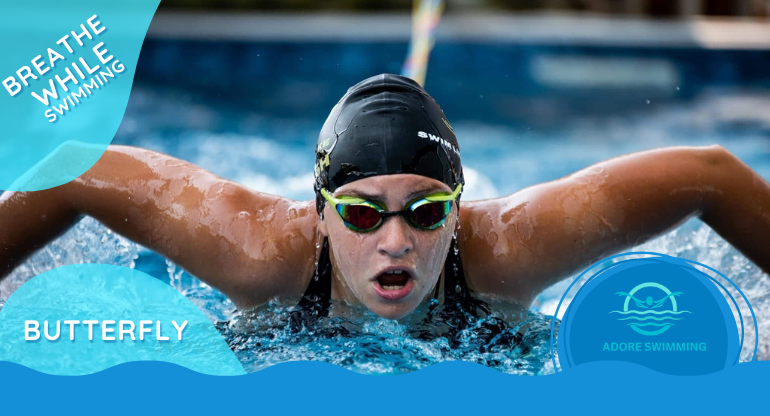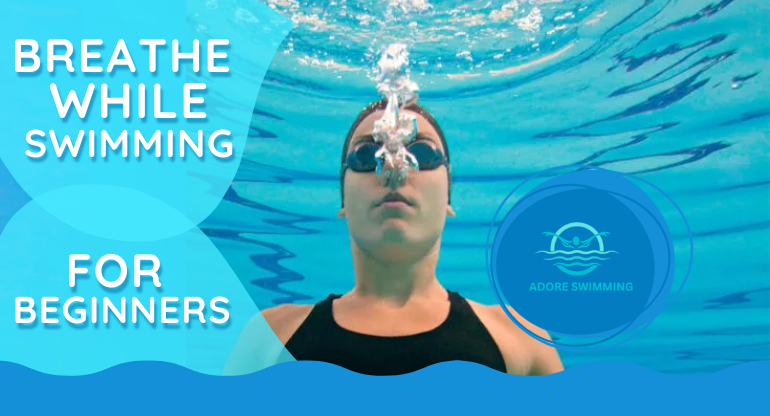How to breathe while swimming for beginners?
| Steps on How to breathe while swimming for beginners? | What to do |
|---|---|
| Relax | Deep breaths before entering water |
| Exhale Underwater | Blow bubbles through nose/mouth |
| Use Equipment | Kickboard, pool buoy, or flotation device |
| Body Rotation | Rotate body and head together |
| Timing | Exhale underwater, inhale quickly when turning head |
| Don’t Hold Breath | Always exhale or inhale, never hold |
| Practice Drills | Bubble blowing, kickboard side breathing, bobbing |
| Breathing Rhythm | Breathe every 2–3 strokes, try both sides |
After learning how to breathe in water, remember to read this article about swimming for beginners.
Here’s a beginner’s guide on how to breathe while swimming effectively:
How to breathe in water while swimming?
- Exhale Underwater: Always exhale through your nose or mouth while your face is in the water and blow bubbles. This prevents carbon dioxide buildup and helps you feel less out of breath. You can start exhaling at the wall.
- Inhale When Turning: When you rotate your head to the side to breathe, inhale quickly through your mouth (not your nose), then return your face to the water and begin exhaling again.
- Don’t Hold Your Breath: Never hold your breath while swimming. You should be either inhaling or exhaling at all times—never both at once, and never neither. The rhythm is: exhale underwater, turn head to inhale, repeat.
- Body Position and Rotation: Turn your head with your chin toward your shoulder, not by lifting your head up. Your ear should be in the water when you breathe, and only one goggle should be out of the water.
- Practice Drills:
- In deeper water, go up and down, exhaling underwater and inhaling above.
- Use a kickboard, pool buoy, or any flotation device to help you focus on breathing without worrying about floating. Hold a kickboard, kick, and practice turning your head to breathe
- Hold the device with one hand, keep your face in the water, and practice turning your head to the side to breathe while kicking.
- Build a Breathing Rhythm:
- Try to breathe every 2 or 3 strokes to establish a steady rhythm and ensure you’re getting enough air.
- Breathe on both sides (bilateral breathing) to balance your stroke, but start with whichever side feels most comfortable
4 Types of Breathing in swimming (Breathing Tips for Different Strokes)
Different swimming strokes have different breathing techniques:
How to breathe while swimming front crawl (Freestyle)?

- Exhale Underwater:
- As your face is submerged, exhale steadily through your nose or mouth. This can be a slow trickle or a controlled release of air.
- Avoid holding your breath, as this causes CO₂ buildup and increases the urge to gasp for air
- Inhale During Rotation:
- When rotating your head to the side (timed with body roll), take a quick, deep breath through your mouth.
- Only one goggle should leave the water, and your head should turn in sync with your body’s rotation, not lifted upward
- Return to Neutral:
After inhaling, immediately return your face to the water and resume exhaling.
How to breathe while swimming breaststroke?

In this stroke, you can breathe more easily because your head is above the water during most of the movement. Focus on timing your breath with the arm pull.
How to breathe while swimming backstroke?

Since your head is already above the water, breathing is simple. Just keep a steady rhythm and avoid holding your breath.
As your right arm exits the water and begins its recovery overhead, inhale quickly through your mouth. When your left arm starts its recovery, exhale steadily through your nose or mouth
How to breathe while swimming butterfly?

As your hands exit the water and your arms start the recovery phase overhead, your chest and head naturally rise with the body’s undulation.
This is the moment to lift your chin just enough to clear the water and quickly inhale through your mouth.
Exhale steadily underwater as you pull your arms down and your body prepares for the next breath.
Understand the Importance of Breathing
These are the reasons why breathing matters for beginners:
- For maintaining energy and avoiding fatigue when swimming
- Breathing helps you stay calm
- Breathing helps you swim longer distances
- Breathing in the right way ensures a continuous supply of oxygen to your muscles
- Good breathing reduces anxiety and panic attacks
FAQs:
How do beginners practice breathing for swimming?
- Stand at the pool’s edge or in shallow water, put your face in, and slowly exhale through your nose or mouth, creating bubbles. Lift your head to inhale, then repeat.
- Stand in deep water (at least a foot over your head), and go up and down, exhaling underwater and inhaling quickly when your head is above water
- Hold a kickboard with one arm, kick, and practice turning your head to the side to breathe while keeping your body horizontal.
- Rotate all the way onto your back to breathe, then roll back to your front.
How to breathe underwater for a beginner?
exhale through your nose or mouth to create bubbles.
When swimming do you breathe through the nose or mouth?
Exhaling through both the mouth and nose while swimming offers several practical benefits:
- clear your lungs more quickly
- Using your nose prevents water from entering during underwater phases
- Maintain healthy nasal passages
- using nose for more relation and mouth for quick exhalations
How to train your lungs for swimming?
- Swim distances (like 25s or 50s) while gradually reducing the number of breaths you take per length. For example, breathe every 3, 5, or 7 strokes, or do sets where you take fewer breaths each length.
- Inhale for 4 seconds, hold for 4, exhale for 4, and hold empty for 4.
Why am I out of breath when swimming?
These are the reasons:
- Holding your breath, not exhaling fully underwater.
- Nervousness in the water
- Not drinking enough water before swimming
- asthma or other breathing problems
- Inefficient strokes or body position increase drag and require more energy
How to not drink water while swimming?
- Continuously exhale through your nose or mouth while your face is submerged.
- When inhaling, curl the back of your tongue against the roof of your mouth. This helps block water from entering your throat.
- Instead of lifting your head straight up, focus on rolling your body and turning your head to the side with your shoulder
- If water gets in your mouth, spit it out before swallowing
What is a major problem with beginner swimmers related to breathing?
A major problem for beginner swimmers related to breathing is holding their breath underwater instead of exhaling steadily.
How can I swim longer without getting out of breath?
- Exhaling completely underwater ensures your lungs are ready to take in fresh air when you turn your head to breathe.
- When you rotate your head to breathe, take a quick, deep breath
- Rather than shallow chest breathing, focus on deep belly breathing (diaphragmatic breathing)



Leave A Comment